This episode Scot revisits stories of the most amazing building he’s ever been to, the Taj Mahal, and the magic that happens to it during an Indian sunrise.
Scot also looks more locally to see if there is anything around his area that can help recreate this experience and even complete a part of it he could never do in India.
Trying something new this time for the webpage, here’s a rough transcript of the episode, with the images and videos inserted into the transcript where they came up in the episode.
Hi, and welcome to The Perfect Show. I’m your host, Scot Maupin. I’m what you might call a perfection prospector, sifting through life looking for little things or experiences that could be considered ‘perfect.’ Join me each episode as I examine one topic that I’m presenting as a little nugget of perfection.
Photographs usually do a pretty good job of showing you what something looks like. The colors, shapes, sort of giving you a sense of that thing. Photography is built around this idea. TV and movies are built around this idea. Online shopping is built around this idea.
Photographers and cinematographers know how to take the time to make something look so great, it looks even better than the real thing.
But then there are those things that are so amazing in person, so spectacular, that no photo ever does them justice. The best they can manage is a pale imitation. One of those things, for me, is the Taj Mahal.
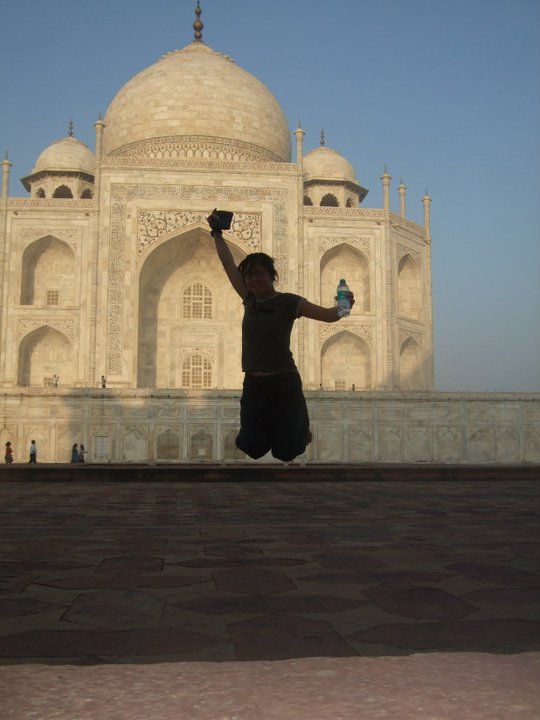
My mom was an elementary school art teacher for 40 years and we always had these gigantic books of different artists’ works with huge detailed pictures of their paintings. She would use them as resources in class to show students and for her own classes as she worked on her Master’s degree in the summers. Monet, Dali, Rockwell, Picasso, Gauguin, Van Gogh, Matisse, I was flipping through all of them over and over from an early age.
We would also go regularly to the Nelson-Atkins art museum in Kansas City, so I grew up seeing paintings both in books and in-person a lot. It got me interested in art, eventually allowing me to enter college on an art scholarship, and pretty much affected everything in my life.
During college, I would have one art history course each semester, which would put me in a big auditorium twice a week looking at giant projections of paintings on a screen.
One summer while traveling through Chicago I made a visit to the Chicago Institute of Art museum, where I got to see a traveling exhibit of Van Gogh paintings including one that I had seen on the screen in art history class, and also in my mom’s books. It was small in real life. Smaller than the giant screen projection, of course, but also smaller than the reproduction of it I had seen in the book.
The real painting was smaller than a piece of printer paper, which really surprised me. And modest, it wasn’t showy at all. It was just a small painting of the sun setting over a wheat field.
I really didn’t pay attention to it much on the screen or in the book. Just flipped right past it, but then there, in person, it stopped me in my tracks.
I remember having the absurd initial reaction of thinking they shouldn’t allow photos of this to be in books or online because you just lose so much. The type of thing where it feels almost rude to show people the photograph of it first and let them think they’ve seen what the real thing is like. Pictures hadn’t shown me the texture that the globs of paint had or really represented the vibrance of the colors well at all.
I hadn’t had this sort of a jarring disconnect when seeing any other paintings before, and I had seen a lot of paintings. This was just the one for me. It shot to the top of my list immediately. The photos had shown me what the image looked like, but not at all what it was like to actually see the painting, if that makes any sense.
Like a replica that doesn’t really replicate the thing.
Now this sort of phenomenon has happened multiple times over my life. Most often with landscapes, or sunsets – stuff that often just flattens and dies in a photo.
It’s happened a few times with paintings, like the one in Chicago, and once with a building. That building was the famous Taj Mahal in India.
I mentioned last episode that I had my honeymoon in India, and we went there without a real plan apart from visiting the ‘Golden Triangle’ trio of tourism cities, which are Delhi, Agra, and Jaipur, and then adding on a fourth city, Udaipur.
Ok, so it’s geography time again…
This is beginning to become a regular feature on the show, I guess, but the Golden Triangle is that trio of cities in the northern part of India. India’s total population is 1.38 billion. Delhi, India’s capital city, holds 18 million of those people.
Then to the south of Delhi 220 km, or 137 miles – a 2-3 hour train ride away – is Agra, a beautiful city known for The Agra Fort, but more famously for The Taj Mahal, which sits in Agra on the banks of the Yamuna River.
Northwest of Agra about the same distance, 230 km or 143 miles – a 3-4 hour train ride away – is Jaipiur, also known as ‘The Pink City,’ and it’s a center for a huge market of shops and bazaars and trade.
Then Jaipur is 260 kilometers from Delhi again. These three cities form a rough triangle, and that’s the Golden Triangle that people talk of when they are talking about India.
Down southwest of Jaipur nearly 400 kilometers, or almost 250 miles, outside the golden triangle, is the city of Udaipur. It’s a 7-8 hour train ride, so that’s an all-day thing from Jaipur, or an overnight thing from Delhi.
Udaipur is a city built around a huge manmade lake called Lake Pichola. I say manmade and because I’m an American that always serves up a certain connotation in my mind as to what time period we’re talking about, but India is a way different place, with a way different timeline, so you have to adjust a bit to how that changes things. This manmade lake was completed in 1362, nearly 700 years ago.
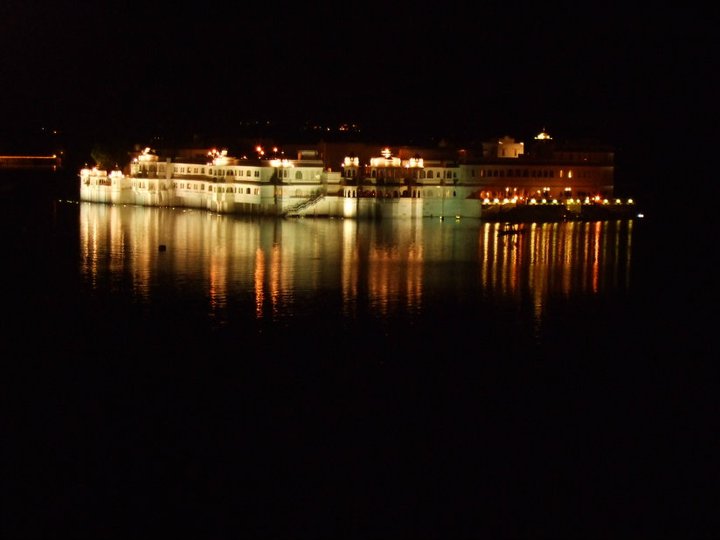
Lake Pichola has one island with a super-fancy hotel on it. I mean the hotel is the island, out in the middle of the lake, and it looks like a palace. This was featured prominently in the James Bond movie, ‘Octopussy,’ and restaurants around the lake continually remind you of that point by trying to beckon you to their nightly viewings of the film over a lake backdrop, but more on that later.
I had talked my wife, Misha, into my bright idea of landing in India with zero plans or reservations of any kind because I read to be wary of online reservations and getting a bait and switch when you register for hotels that way. So I thought it would be better to just be dropped off somewhere central, make our way to lodging, and then inspect it when we got there.
Of course, this was, as my ideas can sometimes be, terribly underthought-through. I’m far too quick to just think ‘Ah, it’ll probably work out somehow.’ and not plan too much for the trip. We hopped off the plane late, I think 9 or 10 at night, hailed a cab, and asked for a ride to the New Delhi train station.
People sometimes use Delhi and New Delhi interchangeably, but there is a difference. New Delhi is one of the districts within the larger city of Delhi. While the larger city of Delhi has been in place since the 6th century BC, New Delhi was really overhauled, restructured, and remade in 1911 by the British when they occupied India.
A lot of the buildings and roads are made with European architecture influences, so it’s a trip to go from outer Delhi into New Delhi and start seeing that British influence on things like Connaught Place, a large shopping area.
New Delhi is where India’s seat of government is, and holds India’s capital, but New Delhi is only 42.7 square kilometers compared to all of Delhi, which is over 46,000 square kilometers. Using Delhi and New Delhi interchangeably would be like using “San Francisco” interchangeably with “Fisherman’s Wharf.”
So it was the New Delhi train station where we had asked to be dropped off that night on our cab ride from the airport.
I thought that seemed like a good place to orient ourselves, check the maps, and make a plan, so we hopped out and started plotting our moves right there in front of the station… which had the effect of inviting other people to try and insert themselves into that process.
We got approached almost instantly by many eager gentlemen keen to show us to the spot we just must be looking for. We knew about these guys, too. They get a cut from the hotel if they can bring in paying customers, so they will say anything they need to, not so much making sure it’s all true.
So we just started walking instead, which momentarily kept people from taking an interest in us. Stopping, especially to consult a map or book, though, would get us swarmed with unhelpful helpers offering unhelpful help.
We must have looked like bright shiny idiots that night, a beacon calling out for anyone who wanted to test their luck on the two new kids. We hadn’t really gotten a chance to get our India legs yet.
Ultimately, we stayed at a nicer place than we had budgeted for because of this, willing to call off our search because it was late, the place was very nice, it would only be for the one night, we were exhausted, and besides, this was a honeymoon, right?
We had planned what cities we would go to, but not what order or how many days we’d stay in any of them, so in the calm of that nice first hotel room we decided that maybe Delhi wasn’t our speed yet, and made plans to hop a train to Agra the next day.
Agra’s a smaller city, I mean everything but Mumbai is a smaller city than Delhi, but Agra is also a slower city. This is the city with the Taj Mahal in it, and its economy largely revolves around the tourism that building attracts. That’s what brought us there.
We had read that the best times to view the Taj were sunrise and sunset, with sunrise being the better of the two. The way tickets to the Taj work is you have to get in line to purchase tickets for that day, separate lines for men and women, get your ticket, then wait in another line for the security check.
There are lots of rules for what you can and can’t bring into the Taj, and they have armed guards who seem pretty serious about you following them.
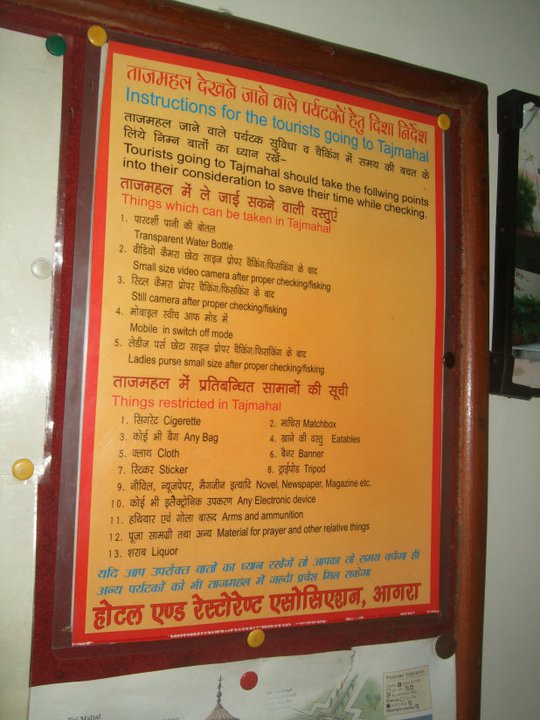
No food or drink, but you could bring a transparent water bottle, meaning like a small, disposable, plastic one. This is all the water you get for your time inside. You can bring your camera, but not a sketch pad, book, or any writing utensils. I was making a sketchbook of my time in India, so I remember this rule well because I had wanted to come in and sketch or draw the Taj Mahal for sure, but found out the night before that I couldn’t bring in my drawing stuff.
I didn’t dig too hard but it does make sense to me on multiple levels. Firstly, of course, keeping out food and drink helps keep food and drink spills from happening on a priceless monument, prevents destructive critters who might want to eat that food and drink from being attracted, and the no pens or pencils thing makes sense too, because while I wanted to bring it in and draw a picture OF the Taj, I can imagine the temptation for people to want to visit and then draw or write ON the Taj.
When I visited Stonehenge, we had to view it from a ways away because they used to let people just walk up and touch the stones, but too many were chipping off small pieces to take home. So they had to rope it off and keep people a certain distance away because if they hadn’t, according to the Stonehenge people, it would have been completely gone at the rate it was being chipped away.
So no one gets a chance to write on the Taj Mahal because we as a species completely can’t control ourselves and we deface and destroy pretty much anything and everything when given even the slightest chance? Yeah, that seems about right.
They are very serious about keeping the place nice, and they post lists all over of all the prohibited items, We saw ours out front of our hotel the night before in time to leave anything on the list back in our room, and you’d be wise to take note of these signs because if you bring something on them with you, either it’s not getting in or you’re not getting in, ticket or no.
Items on the website and sign include drones, any tobacco products, firearms, candy, wire, bags of any kind, stickers of any kind, tripods, or materials for prayer, also no electronic devices apart from your camera and phone.
Mobile phones are to be switched off or on silent when you are inside, and they ask you not to make noise in or around the mausoleum. They even enforce a half-kilometer radius from the Taj where you can’t operate any polluting vehicles so that less smog would be in the air to stain the monument.
That might be the most impressive ban to me, because Agra may be comparatively small to Delhi, but it still holds 1.6 million people. I’ll tell you anywhere else we went in India, a zone like that seemed like a completely impossible thing to establish and maintain.
Even so, The Taj Mahal doesn’t avoid all pollution, and every so often it undergoes a process called multiani mitti, a traditional mudpack, where mud is caked on by hand, and then brushed off, and then the brilliant white shine returns until it’s time for another rejuvenation.
Other items on the banned list might seem more curious at first. Books of any kind, tripods, phone chargers, or extra batteries, prayer materials, but this ties-in to the second reason why I couldn’t bring my sketchbook with me.
That reason, I think, is a less obvious one, though. The Taj grounds are open from just before sun up to just after sundown, but your ticket is only good for entry once, no re-entry. So if you wanted to come in and see the sunrise and sunset, you’d need to stay all day and not go out. Stay all day without food, with whatever small amount of water you got in with, under the heat of the Indian sun.
Extended drawing projects, books to read, cell phone recharges, or meals would make it easier for people to stay longer, which means the site gets more crowded, less magical, fewer people get to cycle in per day, they sell fewer tickets and make less money on the attraction as a whole.
Speaking of tickets, they are different prices depending on your nationality. For Indians the tickets are 50 rupees, about $1 when I was there, or 64 cents now, google tells me. For foreigners, the price is 1100 rupees, with an additional 200 rupee fee if you want to go up and see the main mausoleum building, which you should definitely do. To go all that way and not see the main thing, I mean, just count the 200 rupees in the price of the ticket, so 1300 rupees total, or $16.74 today. Oh, and currently you have to buy all tickets online, they don’t have the in-person ticket window open because of Covid.
When Misha and I went in 2009 it was 500 rupees for the ticket plus 250 for the mausoleum add-on, so 750 rupees total, which was about $15 then, so not that different comparatively.
It makes sense that the prices are so contrasted between Indian and non-Indian. It’s an important Indian site, and it should really be accessible to everyone there. Also, the levels of wages and cost of living disparity between India and the countries people come to visit the Taj from really makes it necessary to set the separate prices.
Since we wanted to see the sunrise, we requested a wake-up call for like 3 am the next morning, – a wake-up call which ended up being a person coming over from the hotel office and banging loudly on our door with both fists- and then made our way in the dark over to the Taj gates for sunrise.
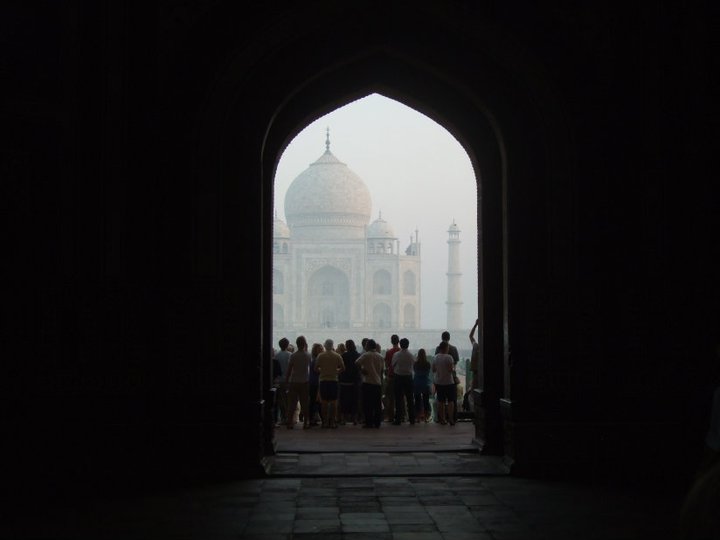
You can see the top of the Taj Mahal from some places around it, but the grounds have a tall, red, sandstone wall around them which makes going inside the only way to really see the front of the structure.
After getting through security there’s a large lawn with a long, beautiful pool and some walkways between you and the main buildings. Those main buildings are up on a raised platform above ground level. This is the view of the Taj Mahal that probably 99% of the world is familiar with: the pool of water reflecting the structure to make a second image of the Taj Mahal for the photo.
We were among the first people being let in that day, so we made our way pretty directly to the main buildings. I remember it being quiet. India had been a place that up to that point had seemed extremely loud to me, with sounds always coming from every direction, but this was quiet, tranquil even, considering I was among a bunch of other tourists at that very moment.
At the base of the platform there is a spot to put your shoes. It’s optional, but I’m really glad that I did it because without my sandals, I was able to stand foot to marble on one of the most amazing structures on earth. I remember the ground being cool, not cold, but more than anything I remember it being remarkably smooth under my bare feet.
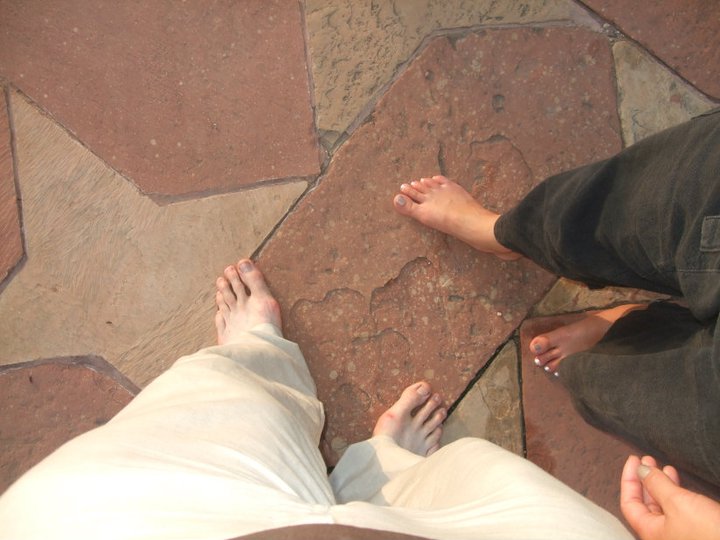
Shah Jahan was emperor of the Mughal empire, which controlled a giant chunk of south Asia, and was, in many ways, India before India. He had the Taj commissioned as a mausoleum to house the tomb of his favorite wife, Mumtaz Mahal, who died while giving birth to her 14th child. Wow, 14th…
Okay, so there’s the white main building most people are familiar with, but the Taj Mahal complex is actually three buildings next to each other. On either side of the white marble Taj Mahal are giant red sandstone buildings that face inward towards the Taj. One is a mosque, that’s clear, the other one’s purpose is a bit more ambiguous.
Theories are that it could have been a guest house or used for something else, it could even have been built just to ‘balance out’ the mosque, and make the site more symmetrical. I read that theory, too, but it seems the knowledge of why it was originally built has been lost over the ages.
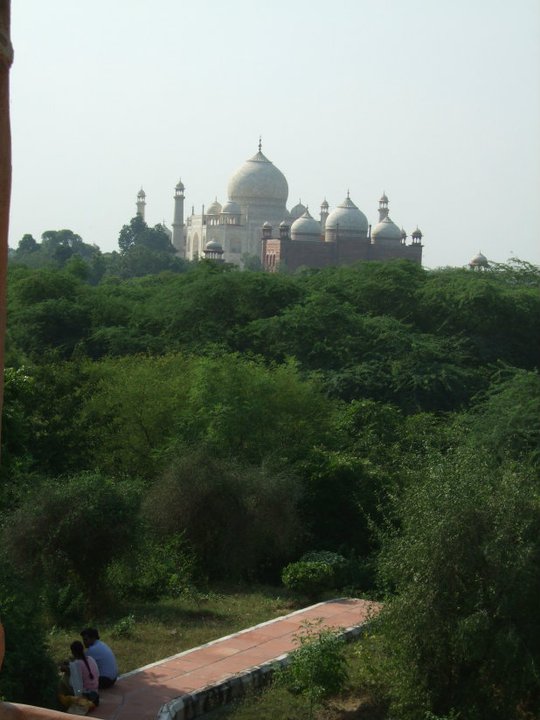
The mausoleum in the center, what most people think of when they imagine the Taj Mahal, is made of white marble with intricate carvings and inlaid precious stones. Most Mughal buildings of that time were constructed of the red sandstone that make up the buildings to its side, and the nearby Agra Fort, but Shah Jahan wanted The Taj made out of white marble, and he was sort of was the first person who did that, and it caused a wave of similar design in Mughal architecture following the Taj.
The building is 73 meters or 240 feet tall at the tip, which includes the famous large onion-shaped bulb on top that accounts for 35 meters or 115 feet of that height.
The precious stones are inlaid in pietra dura designs, which look like vines and flowers on some of the marble surfaces in beautiful circular and overlapping patterns.
The building is also surrounded by four tall white minarets, or columns, on the four corners of the platform. These minarets are 40 meters or 130 feet tall, and an interesting bit of trivia is that they aren’t perfectly vertical. All four of them lean slightly away from the Taj Mahal’s main structure, so that in the event that they were to collapse or be toppled over, something that happened from time to time, Wikipedia says, then they would fall away from that main building and be less likely to damage it.
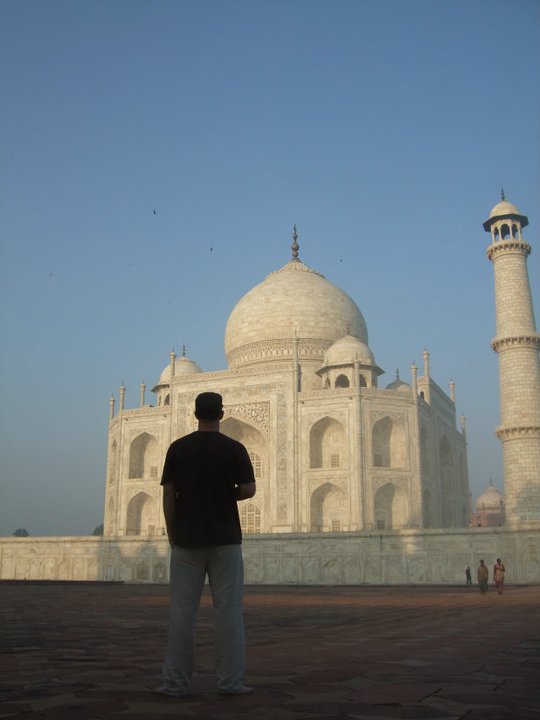
So the main reason why we were there at sunrise, and why the guide books suggested it, was that during sunrise the Taj Mahal was supposed to change colors as you watch. Well, I mean, it doesn’t actually change colors, but it appears to be different colors at different points in the sunrise. That was the claim anyhow, so we were there in part to test it out.
By the time we reached the building it was a bit lighter in the sky, close to sunrise. And over the next several minutes we watched the sun come up and its effects on the Taj Mahal. There’s a lot going on with this building, so the best place to see this color change effect is via the smooth large bulb on top.
Because of the dome’s height, the colors sort of start there, and then wash down over the rest of the building gradually.
In the beginning, the whole structure is a blueish hue in the early morning light, with the cool night sky behind it. Then the structure almost imperceptively shifts to a beautiful pink briefly, first on the dome, then down over the whole thing, followed by a gorgeous yellow for a bit, and then ultimately transitions to the brilliant white that it wears for the rest of the day.
I’ve never seen the Northern Lights, but I imagine that’s the same feeling, of planning it out and then being in the right place at the right time to witness a phenomenon.
I locked that moment into my memory, with the cool wind blowing and quiet conversations in many languages just barely audible in the background, watching the most amazing building I had ever seen in person magically change colors before my eyes.
Actually, it was really the most stunning uh.. created thing I had ever seen up to that point, or even after. Top #1 thing made by humans that I’ve seen in this world.
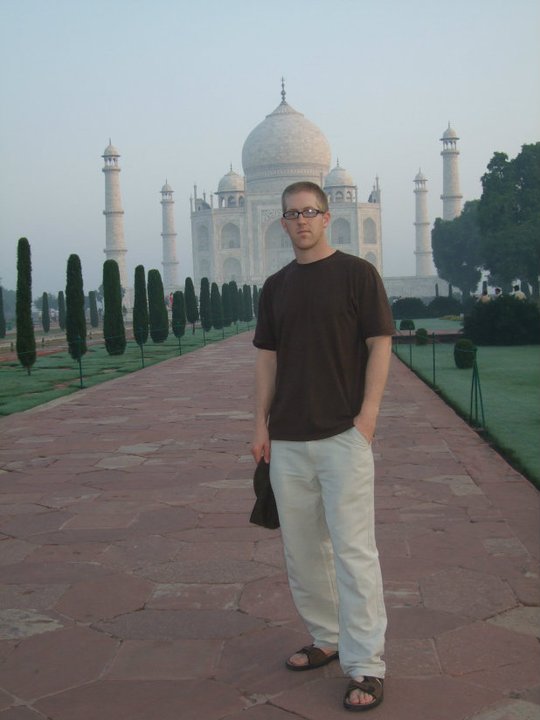
I think it was while watching the color change that the same thought popped into my head again, “There shouldn’t be pictures of this thing. They just flatten what is magnificent about it on so many levels.”
But of course there should be pictures. That would be nuts, right? Sorry, no photos of this thing, it’s too beautiful for photography. But that’s, again, where my brain went when standing before it. Sort of resentful, even, that I thought I knew what this thing looked like from the photos I had seen of it and that no one had told me how different it really was in person.
In the light of the full morning sun, and having successfully seen the thing we were there to see, I went in and explored the rest of the building more leisurely. It’s huge, but also smaller than I expected inside. Or rather, I don’t know what I thought would be inside the main building, but I guess I had imagined it to resemble a house in some way, being divided up into rooms inside. But that’s not what it was like at all.
There’s no electricity there, maybe that’s obvious, but it means that inside you can look at the mausoleum and touch blocks of marble that were intricately carved hundreds of years ago, but the light you’re working with is whatever has made its way in from outside and then was not also being blocked out by other tourists.
That’s one reason why it’s great to go first thing, there aren’t nearly as many people there with you, but then again there isn’t nearly as much light to see details by either.
Inside the center of the structure are two ornate tombs, one for Shah Jahan’s wife Mumtaz Mahal, and the other for Shah Jahan himself who died in 1658, only 5 years after the completion of construction on the Taj. Well, actually, Wikipedia says the main building mausoleum part was essentially done in 1643 but work on other phases continued for the next 10 years so really he died more like 15 years after the Taj was built.
These two ornate tombs, however, are both empty inside. The real tombs for Shah Jahan and his wife are on a lower level, closed off, and arranged very specifically with their heads turned to face Mecca.
After exploring the main building, we explored the mosque and the maybe-guest-house/maybe-just-built-to-be-symmetrical-house on either side of the mausoleum. They were less crowded by far, but I kept turning back and looking at the Taj from whatever other building we were at. I just couldn’t help it.
Meanwhile I of course took tons of photos. Some of the Taj, some of us in front of the Taj, the thing where you pretend you’re touching the tip of the dome from the right angle or whatever. When push came to shove the ‘there shouldn’t be pictures’ thing didn’t really slow me down any here, I don’t think.
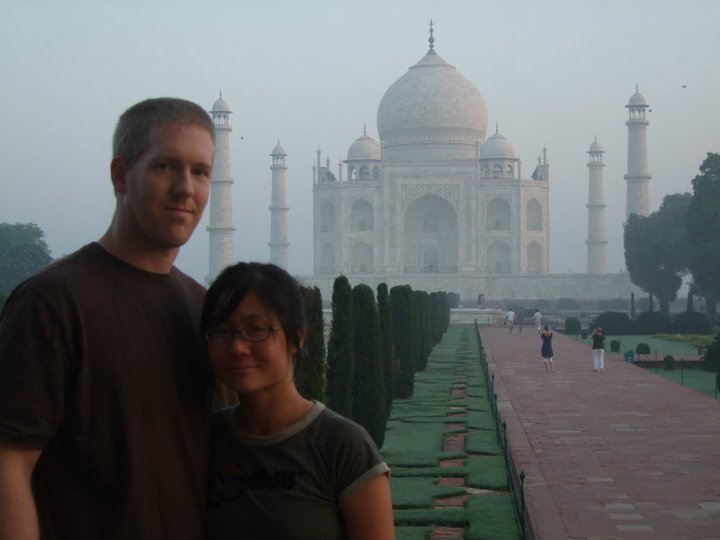
I remember hanging out on the grounds for a little while. Soaking in the everything-I-could until probably mid-morning, when we decided it was about the right time to head out.
After a short nap to recharge in the hotel, we were back out on the streets of Agra, and I was still processing the Taj Mahal. We had come to Agra just to see it, and now that we had we were planning on leaving Agra the following day but I was still churning over the experience that had floored me that morning.
The next day we would be hopping a train to the third city on our journey, but that also meant one more sunrise here, and I was keen to try for a second bite of the apple with seeing the Taj Mahal. The problem was, however, that this would be a Friday morning, and the gates of the Taj are closed on Fridays, so no tickets, and no one inside the walls.
But there were other options. There’s an entire side-industry based around every way possible to see the Taj without going through those gates, and Friday, of course, was the busiest day of the week.
The monument is built on the western banks of the Yamuna river, a big waterway which runs through Delhi, through Agra, behind the Taj, and eventually into the Ganges River. So the next morning before sunrise we walked down to the water, where you can hire a boat to take you out to see the Taj from the river.
This is probably the second most famous view of the Taj, and if in pictures you are seeing it reflected over a wide stretch of water and not a narrow one, that’s the Yamuna river and you’re seeing it from the back angle.
This is also possible because those tall red sandstone walls that go around the monument stop at the banks of the river and there’s no wall around the back side. So it might seem like this would be a good place to slip around the edge and get in for free, but the multiple armed guards I saw patroling these points might disagree.
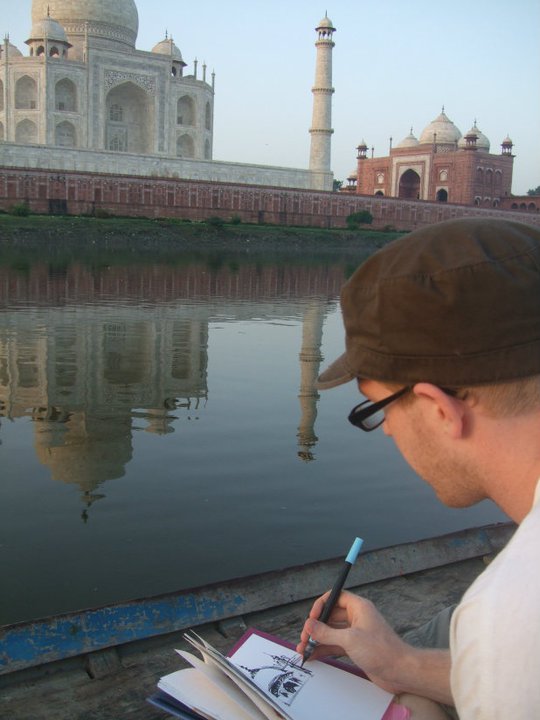
We found a boatsman with a large flat wooden barge type thing, negotiated a price, and then he used a long stick to propel us slowly out into the middle of the Yamuna waters, like you’d see them use in canals in Venice. The river was pretty calm, making it nice to lay back on the barge and check out the view we had just paid to see again.
The sunrise was amazing, as sunrises usually are, but while the skies lit up in different colors, from this orientation they didn’t have the same effect on the Taj Mahal, well I mean not on the side we could see, which was the backside. The early morning light changed colors again but the Taj really didn’t, this time. I think I caught a little of it off on the sides of the bulbs and column, maybe, but not really the same at all.
The boatsman hadn’t been as strict with his security procedures so I had brought a backpack aboard that I was using as a pillow, and I had also brought my sketchbook with some pens and pencils.
I sat up after we got a good enough view and started drawing, the boat was moving constantly, changing the angles of what I was seeing so I had to work fast. I managed a few quick sketches in pencil and then spent the rest of the ride trying to work on one in ink.
I enjoyed drawing, as I usually do, but I wish I could have had longer, or been on a more stationary point to work from. Still, this was letting me draw the Taj Mahal, which 24 hours ago had not been possible, so I wasn’t trying to look any gift horses in any mouths.
We went back to the shore after a bit, got off the boat while the boatsman negotiated with new riders, and walked back up to the city for the rest of the morning until our departure time. We had checked out of our hotel that morning so today we would just have to power through until we boarded the train.
We were joined for part of our walk by a skittering pack of monkeys loudly running away from some absentminded tourist who had apparently left their bags of chips and snacks a little too unguarded.
And that was it for Agra. We went to the station after lunch, and hopped on the train to the next city on our itinerary, Jaipur.
We did a little exploring and shopping in Jaipur, went to see a bollywood movie from the balcony of the famous Raj Mandir theater there, but for me, nothing there really compared to the Taj Mahal. I think the city itself was maybe full of more interesting points than Agra, but none of those points peaked as high as the Taj did in my book, if that makes sense.
Oh, for the movie we just went to see whatever was playing, which ended up being the perfect one for us. The film is called Dil Bole Hadippa, and it….well, let’s just say it isn’t rated strongly on IMDB but we quite liked it, maybe even for the same reason that IMDB viewers didn’t.
What confusion and hilarious mix-ups which ensue! Oh, the elaborate shenanigans she must concoct! We’re talking toodle-oo, drive-by fruiting, Mrs. Doubtfire levels. Like a reverse-Ladybugs, with Jonathan Brandis.
It was about cricket, which I don’t really understand, and in Hindi, which I understand even less, but the gender-swapping love story part was simple enough that we followed along just fine, with killer songs and elaborate dance numbers along the way, complete with long flowing strips of colorful cloth and ferris wheels. Just delightful.
Buying tickets for the movie had been a little bit tricky, though. Many places in India, and this was true for tickets to get into the Taj Mahal as well, there are two lines to buy tickets, one for men, or Gents, as they would label it, and one for women, or Ladies, as its label would read. Ladies and Gents, those were the two terms I saw everywhere.
The Gents’ line was way shorter so I just hopped into it first and it turns out that when I got to the front I only had access to tickets for the lower sections, as a man, which meant I could buy tickets for certain areas of the theater but not the higher balconies.
I left my line and tagged Misha in, so she got into the ladies’ line and was able to buy tickets in any section, including the balconies. The reason for this was so that single women going to the theater could sit in separate sections and not be, well let me be blunt here, but to not be harassed and creeped on by single men.
So women had access to more parts of the theater, and married couples wanted to sit in those nicer sections of the theater too, so the ladies line was long because it represented single women and the women half of many married couples looking to buy tickets in those nicer sections like how we were.
But we got balcony seats, ate samosas, loved the movie, and just the whole experience was wonderful.
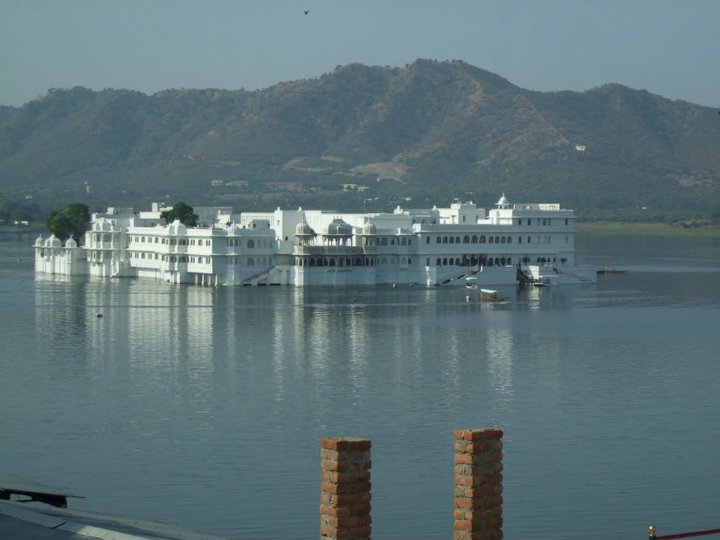
Our next destination was Udaipur, remember, the city built around that lake from Octopussy? And we had more adventures here. We did eventually cave to one of the constant barkers wanting us to come watch that James Bond movie over dinner.
And whatever we were expecting…wasn’t what it was. We walked up some narrow steps to the roof of a building near the lake and sat at one of the tables. There were no other customers, we were the first, but it wasn’t that late yet so we were probably just early for dinner. However when we got midway through the meal and there was still no one else around we asked about the James Bond movie, you know, the thing that we had come here primarily for, that the guy on the street had literally said come upstairs and watch it while you eat, that one.
Up on the roof was a big, rectangular cement block wall that had been painted white. Now I’ve been to a lot of theaters and I know a perfect screen set up when I see one, so I started looking around for the projector.
And sure enough, the guy we had asked about the movie had disappeared and now reappeared with a long extension cord and a rolling cart.
What the man was wheeling out, with the extension cord, wasn’t a projector, though, but a small television set on a cart. We’re talking the old kind. With a big, thick Cathode Ray Tube.
Below this TV sat an equally ancient-looking VCR. Uh, do people know what a VCR is? It’s a machine you hook up to a tv and can play video from VHS tapes…which were the way to watch movies before streaming and before DVDs.
He wheeled the small 15-inch screen out and created just a hilarious image for me of watching the movie on that small dark box instead of the massive white wall behind it.
So we finished our meal to Octopussy under the night sky.

The food was good, even if the atmosphere was bizarrely crazy, but actually, pretty much all the food in India was good. We got to have Indian food for every meal, and it was amazing. I don’t remember any of them being bad, but also I don’t remember the food from really any of the meals specifically, it was just great Indian food throughout the whole trip that we had at like a zillion different places.
We deviated a couple of times, both during the Indian holiday of Diwali, which happened while we were there and most, if not all, of the traditional restaurants around us closed shop as people traveled back home to observe and celebrate.
First, we went to go see what Mcdonald’s in India was like, and it was a trip. They don’t serve beef, which may be obvious, or may not be, but people who practice the Hindu religion don’t eat beef, and that’s a sizable percentage of the Indian population. Another sizable chunk of India is Muslim, and practicing Muslims don’t eat pork, so there was none of that at Mcdonald’s either, meaning no hamburgers or bacon, and that meant a ton of sandwich and menu options that I had never seen before.
The McChicken seemed like the flagship item, with a McVeggie by its side because again, a large number of people in India are vegetarian, so all menu items like the Pizza McPuff, another thing I saw, were coded with little green dots to signify they were a vegetarian item, or red dots if they weren’t.
The other western restaurant we tried one night during Diwali was Papa John’s and that was surreal as well. I mean I think it was just pizza with Indian-ish toppings as options, but the fact that we found a Papa John’s there in Connaught Circle, New Delhi of all places, was just wild to me.
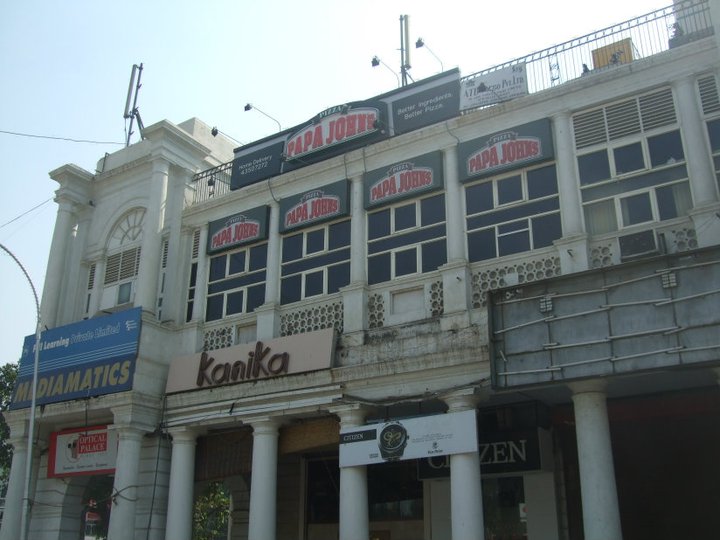
All the Indian restaurants we ate at were chock full of delicious curries, but nothing that really stands out individually, it’s just in my memory that all the food on our trip was really, really, good.
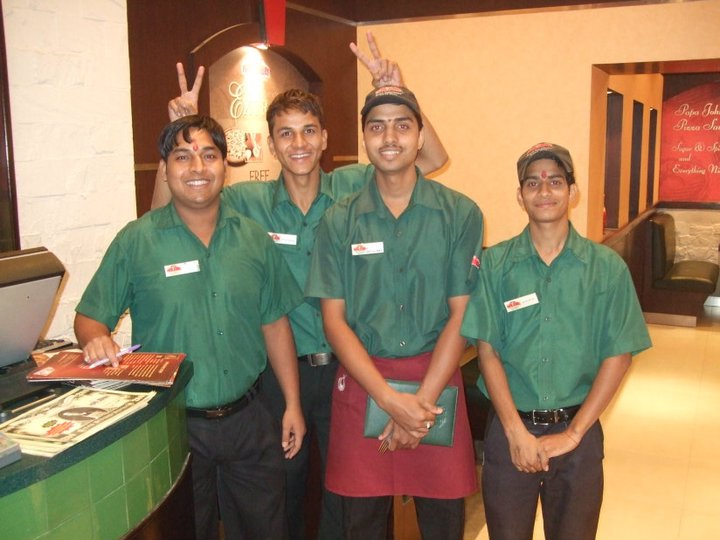
In all I loved my trip to India, I really want to go back and explore different parts, but I also don’t think I would ever turn down a chance to see the Taj again.
I’m obviously not the first one with this take on the Taj Mahal. It’s not even all that unique, I mean, the building is so undeniably impressive that it drives the industry for an entire city. So impressive that it became a symbol for the country, really, one of the biggest countries on earth. People have been inspired by the Taj since it was originally built, and I’m just one in a long, long, line.
Another person ahead of me in that line, would be Bill Harlan. Back in the 1970’s Bill Harlan, a wealthy land developer turned vineyard owner, was so inspired by the Taj Mahal that he decided to build one of his very own.
There are actually several replicas of the Taj Mahal in different parts of the world, enough of them to have their own Wikipedia page, where I would say some are definitely more notable than others.
There are scaled and incomplete replicas in Bangledesh, other replicas or Taj-inspired buildings across India, including the Bibi Ka Maqbara in Aurangabad, built by Shah Jahan’s son in an attempt to outdo his father’s Taj Mahal. Classic father/son stuff. Luckily my dad didn’t build a Taj Mahal so I didn’t have to build one either, but Emporer Aurangzeb wasn’t quite so lucky.
The page lists small Taj replicas in theme parks in India and China, as well as a lego version at Legoland Malaysia, which I looked up pictures for and it’s impressive. It looks like they made it scale to the size of the lego minifig people.
Some mosques made the list, while not exact Taj replicas, you can tell the clear and heavy inspiration on these partial-copies, but one replica on the list stuck out to me the most. Both because of its location and its description.
The location was Sausalito, California. Less than an hour from where I live in Oakland. The second interesting thing about this entry was the replica’s title itself. It’s listed as the ‘Taj Mahal Houseboat.’ What?
Google calls it the Floating Taj Mahal. It’s a houseboat that was built with distinct architechure inspired by the real Taj Mahal and this is the replica that Bill Harlan decided to make 50 years ago.
Ok, Here we go. The kid from Kansas is about to talk houseboats. I never grew up around water or boats, really. I certainly didn’t know much about houseboats, so I ended up doing a little bit of research for this.
Now boat-heads, don’t worry. I’m one of you now. I got your back. So first of all, to be qualified as a houseboat it would need to have a motor and a means of navigation. The Taj in Sausalito doesn’t have that, so technically it’s a ‘floating home,’ not a ‘houseboat,’ but the terms have come to be used interchangeably a lot of the time, including during my research, and I may use them that way too, but to all you boat-heads, just know that I know.
So Sausalito, California, has a sizable houseboat community. It dates back to just after World War II when people moved up to the city just across the golden gate bridge from San Francisco, and found calm waters there in Richardson Bay. Without any regulations or rent to pay, there were soon all manner of homes making up this houseboat community. Pretty much anything that floated would do.
Then, during the late 60s a man named Forbes Kiddo decided to do a bit more. He devised a waterproof concrete mixture and a way to mold it into deep concrete hulls as foundations for floating homes. Now it might seem odd to start a floating house with a thick, heavy, concrete base, but it’s durable, you can pour them to have enough depth to displace enough water to float them, and the heavy weight at the bottom allows you to build more significant and elaborate structures on top without worrying about the whole thing wanting to tip or flip over.
Forbes made several of these hulls to varying specifications, but two are far and away the most famous. One is a large floating home called Forbes Island, which bounced around a bunch, but spent many years anchored off a pier in San Francisco as a private restaurant run by Kiddo himself.
The other one is the Floating Taj Mahal. Forbes originally built the 360 ton hull for Prentis Cobb Hale, who had an idea to make a kitschy space to entertain people that would be Taj Mahal themed, but sort of really over the top, like if it was an attraction in Disneyland.
They drew up plans and constructed the hull in 1968 and started building a wooden structure to go inside in 1969, but eventually Hale had to abandon the project.
That’s where Bill Harlan stepped in, as I said before Harlan made his money in real estate before turning to follow his passions and become a vinyard owner. He followed his passions with the Floating Taj plans too, overhauling the ideas that Hale had drafted and wanting to make the structure less about a stereotypical aestetic and more authentic instead.
So, in the 70’s Harlan went to India on a research trip for 5-6 months where he studied mughal and moorish architecture, as well as studying the large houseboat communities that exist on the Dal Lake in Kashmir, india, and in Aberdeen, Hong Kong.
Armed with new knowledge and experiences, when Harlan returned he set out to build the shell of the Floating Taj and incorporate everything he learned on his travels.
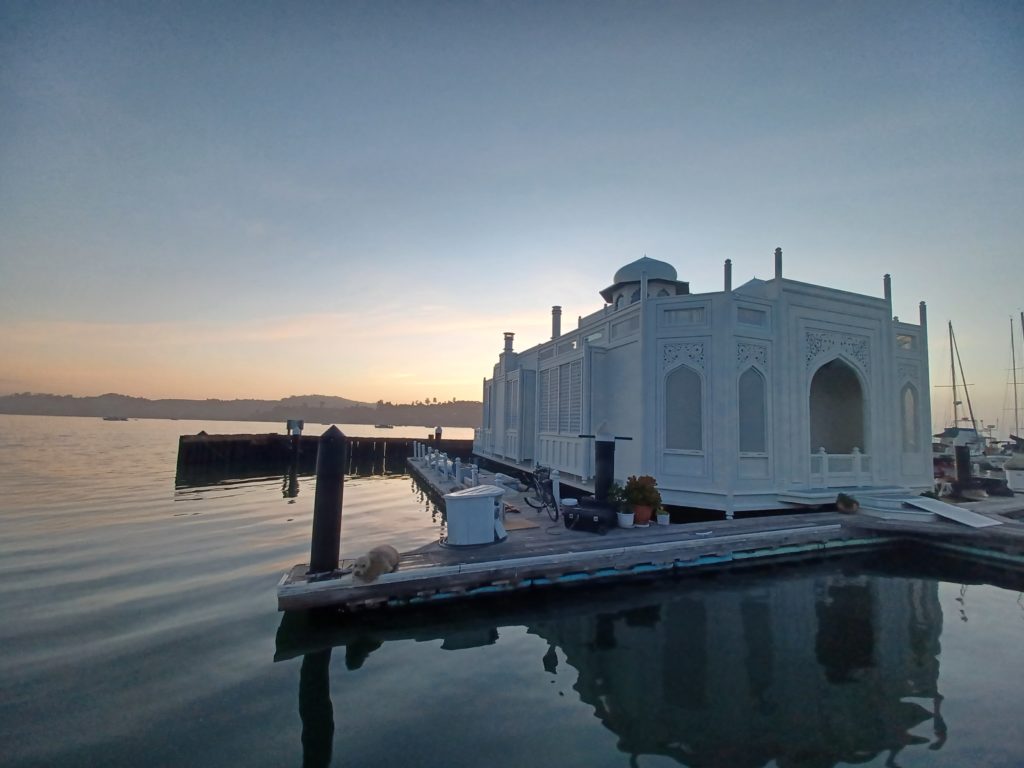
The structure he built is pretty spectacular, and different from any other houseboat in existence. Some changes from the design of the real Taj Mahal, like scrapping a large central dome for two smaller domes closer to the sides, which are made of fiberglass, not marble, of course, were just practical decisions based on physics and buoyancy.
When finished, the Floating Taj was three levels, with 12 rooms, making up 4500 square feet. There’s an elevator, a staircase, a wine cellar, a spa and jacuzzi downstairs in the master bathroom, and much more.
He designed the spaces and shapes to mimic the architecture he had studied, and the briliant white floating Taj became a fixture in Richardson bay. He outfitted the windows and door portals with fillagreed openings, meaning those little scallop shapes along the top of the pointed openings.
There are pillars inside, a back patio that opens out to the bay, and the wooden exterior has that recognizable pietra dura design on certain panels, though this one is carved in the wood and painted, intead of being precious gems inlaid in marble.
In the 80s when they reworked the zoning regulations to better define what did and did not constitute a houseboat, many of the odd structures people had been living on were cleared out. A marina with spaces for houseboats was established, and the berths quickly got filled up, meaning everyone else would have to find another spot to live. The Taj got one of the berths at the marina and it has been there ever since.
After completing its construction Harlan lived there with his wife and son, who grew up inside the home, for 25 years. They sold it in 2007 to John and Rhonda Luongo, who updated and fixed up a lot of the structure, and also, curiously to me, painted the white houseboat a ‘blue-green tinted taupe,’ according to Rhonda Luongo, because of it’s “lack of high contrast with the shades of the water.”
As a person who has tried not to stick out before in a place where I clearly stick out no matter what this seems like an odd choice. I mean, looking at pictures of the floating Taj it’s clear that it’s totally going to stick out no matter what color you paint it.
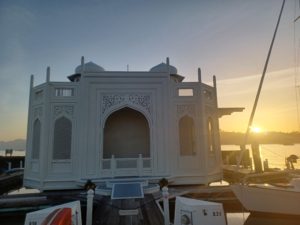
The floating Taj has been sold a few more times since, operating for a bit as a bed and breakfast, and the last several years as a private residence. You can get glimpses of the spaces and the views inside from an instagram account run by the current owners, which has the handle @TajMahalsausalitoofficial, which will be in the show notes, and you can see pretty cool views of the Floating Taj from these pictures….
…but my whole thing this episode was that pictures don’t always tell the full story, and this Taj Replica is close enough I could go there myself and see how good a job these pictures do at giving a sense of this Taj Mahal replica, and how good the replica does at giving a sense of the real Taj Mahal in India.
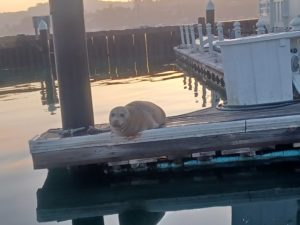

So one morning I packed up my recorder before dawn, and headed out on a little quest.
[FIRST BIT OF TAPE]
The houseboat is moored in a marina, but just like a house on a public street, you can walk up to check it out as long as you are respectful about it.
[MORE TAPE]
So then I was sitting and watching the sunrise with my new friend.
[MORE TAPE]
And watch him I did. I cut the tape way down to make you not have to listen to the sunrise in real time, but also to remove about a million cutesy noises to the seal.
[MORE TAPE]
This was before I had learned the term Pietra Dura, but that’s exactly what I am trying to describe there.
[MORE TAPE]
There was a lot different between this floating Taj Mahal and the real one, of course, and seeing it didn’t really give me any deja vu of India or anything, but I wasn’t just here to watch the sunrise. I was also here to do one thing I could never do at the real Taj.
[MORE TAPE]
So I loaded up my painting kit in the car, and I had to switch to recording with my phone because I discovered my SD card was about to be full, so if you detect a difference in the audio from before, that’s why.
And I painted for about two hours, which I’ve condensed down here to under 10 minutes.
[MORE TAPE]
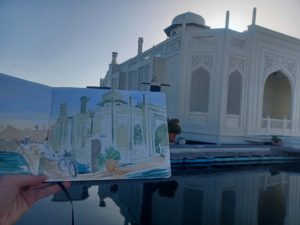
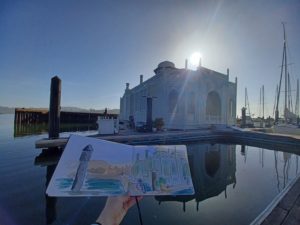
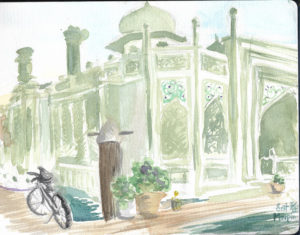
It takes lots of trial and error after error after error to paint a good likeness of something. Part of the challenge is getting the colors, perspective, and proportions right, of course, but it’s also to capture the essence of the thing, and have that come through the painting as well.
Photographs depict perspective and proportions pretty perfectly , but at least with that Van Gogh painting and the Taj Mahal they don’t really do the part about capturing the essence well.
In the end, this replica of the Taj Mahal, the floating Taj Mahal houseboat, wasn’t at all like seeing the real Taj. It didn’t have the same feeling, the same energy, that made the real Taj so astounding, so in that sense, as a replica, it doesn’t really compare to seeing the real thing.
But that’s kind of where this story started, too. The floating Taj wasn’t a good representation of the real building, but none of the hundreds of photos I had seen of it were, either.
The Taj is one of a kind, it’s one of the wonders of the world for a reason. A photograph may feel like it does the job, and it does to an extent, but in reality, the original building is, like some paintings, like some places in nature, one of those things that can be copied, but never quite perfectly. Things that defy depiction, that resist replication.
But, strangely, the floating Taj did remind me of my time with the real one. As did all of the honeymoon pictures from the Taj Mahal that I went back through for this piece, and I think the difference is having already had the experience in person.
When you haven’t seen the genuine artifact, I do think a photo just leaves out so much, but if it’s already something you’ve experienced, then a picture, or replica, while not showing others what the real thing is like, can trigger in you memories of that real thing and let you swim around a bit in the feelings and thoughts you had at that time.
Does that makes sense? Pictures of a thing before seeing it I think sometimes blunt that experience or are a poor replica of it, but pictures of one of these things that you’ve seen in reality can bring back the vivid memories of it and revitalize those experiences in your mind.
Now I’m not urging everyone to just book passage to India and go see the Taj Mahal for themselves, far from it. It doesn’t need to be that one at all. These spots are around. Big ones, small ones, just things you encounter that you know no picture could do justice.
Things that you know in the moment you have to be there to really appreciate. I think most people come up on a few over the course of a life. A few people are lucky enough to have several of these – more if you go out chasing them, but I think everyone gets the chance to see some, as long as your eyes are open and you’re open to looking for them.
Then after, you can revisit those memories from time to time, wipe the dust off the surfaces and clean the cobwebs out of the corners. Keep the colors from fading. I mean, that’s a little bit of what I do with this whole podcast, attempt to sort of describe and revisit the things from my past that I don’t want to lose, while I try to connect them with something in the present.
The gift I hadn’t expected this episode to give me was the quiet morning of painting and watching the sunrise by myself, well along with my new chonky boi seal friend, of course.

I think that may have been the first sunrise I’ve seen since that morning in India. It seems crazy, but I had really forgotten how magnificent of a sight it can be.
And with that, Sunrise on the Taj Mahal becomes the next entry into the Perfectorium, the index of perfect things.
You can visit it at the new online home for the Perfect Show, perfectshowpodcast.com. A direct link to the Perfectorium is at perfectshowpodcast.com/perfectorium, which is spelled p-e-r-f-e-c-t-o-r-i-u-m.
Special thanks to Trappy808 who did most of the music I used in this episode. You can find the info for all the artists and music credits in the show notes and on this episode’s webpage.
You’ll also find some pictures I took of the Taj and other things in India that I talked about, There will be a scan of the painting I made you can check out, along with photos I took of the floating Taj, the chonky boi, and a little video that shows off both of them.
Contact the show through PerfectShowShow@gmail.com, connect on Twitter, Youtube or Instagram to the name PerfectShowShow, and our call-in number is 616-PerfecZ, that’s 616-737-3329.
This episode was recorded and mixed in South Lake Tahoe, California while my wife and kid are out at a pool. They’re great outside. I, however, have the complexion of someone who should spend the sunniest parts of the day inside making a podcast, and so I have.
Subscribe if you’d like to get every episode, And if you are enjoying these and want to drop The Perfect Show a perfect rating or review, please do. It’s the easiest way to support the show.
And also, can I ask a small favor? If you’re liking these, could you share it some way? I haven’t figured out any sort of a marketing strategy for this apart from making the best episodes I can, but if you can tell someone else who you think might enjoy what I’m doing here, that’s really the way it can grow.
And remember, I didn’t really talk about this enough but if you love Indian food, like I do, then India is actually a fantastic place to get it. Like all over, at tons of places. Just some really good meals. So, yeah, if Indian food is your jam, then that’s really one of the best spots for it…India.
Anyway, until next time. I’m Scot Maupin, and thanks for listening to The Perfect Show.
Music from this episode by:
Trappy808 – https://www.fiverr.com/trappy808_
Gopakumar1830 – https://www.fiverr.com/gopakumar1830
rito_shopify – https://www.fiverr.com/rito_shopify
Tushar Lall – https://youtu.be/Xrk6uRZK38w
mwmusic – https://www.fiverr.com/mwmusic
aarchirecords – https://www.fiverr.com/aarchirecords
Aandy Valentine – https://www.fiverr.com/aandyvalentine
Scot’s India Sketchbook – https://photos.google.com/album/AF1QipM5Q-rMxYzFAzmzOWmUeXGw8RhLAzJ_yUolsQ-y
Floating Taj Sausalito official Instagram – https://www.instagram.com/tajmahalsausalitoofficial/
Research on floating Taj:
https://www.oursausalito.com/houseboats/Taj-Mahal-houseboat.html
https://www.oursausalito.com/houseboats/forbes-island.html
https://www.oursausalito.com/houseboats/houseboats-in-sausalito.html
https://www.indianwineacademy.com/item_4_479.aspx
https://en.wikipedia.org/wiki/Harlan_Estate
https://www.architecturaldigest.com/story/luongo-article-122007
More links:
https://en.wikipedia.org/wiki/Taj_Mahal_replicas_and_derivatives
https://en.wikipedia.org/wiki/Taj_Mahal
https://en.wikipedia.org/wiki/Shah_Jahan